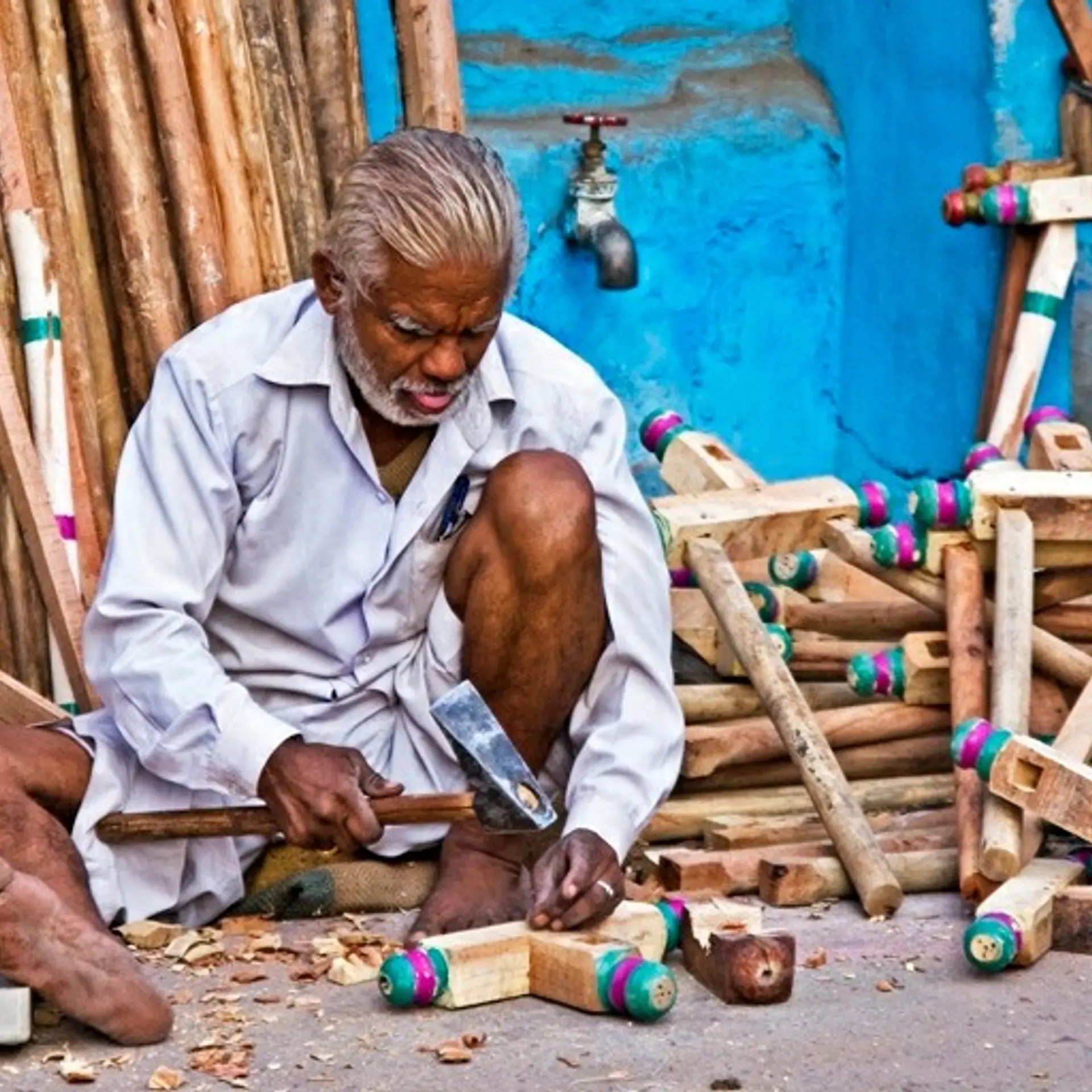

Meet the ‘Rice Saint’ of India
B.K Deva Rao and his son, B.K Parameshwar have been collecting, growing and preserving 155 varieties of Paddy seeds and have become role models in the field of organic farming and water conservation.

Deva Rao in his paddy field located in the scenic foothills of the Western Ghats in Aamei, DK District, Karnataka.
" alt="
Deva Rao in his paddy field located in the scenic foothills of the Western Ghats in Aamei, DK District, Karnataka.
" />For B.K Deva Rao (73), cultivating paddy (rice) has been a way of life for the past 50 years. Living in the times when we hear news about farmer suicides, Deva Rao’s story is one which inspires awe and admiration. Farmers, also called as ‘Anna Dhatha’ (rice giver) form the backbone of our country, have been neglected in the present times. However, Deva Rao has managed to rise above this negativity. For him, cultivating paddy is more of a passion than a means of making money. At the same time, he has mastered a model which is not only economically feasible, but also healthy, environment friendly, and sustainable.
He, along with his wife Sharada (71), son Parameshwar (51), daughter Harini (45) and daughter-in-law Vasanthalaxmi (39) are a self-sustained, independent and successful agrarian family. This family owns about 30 acres of land at Aamei in the remote village of Mithabagilu in Belthangady Taluk, Dakshina Kannada (D.K) district of Karnataka (around 15 kms from Ujire Town).
In this land, they collect and grow 155 varieties of paddy seeds in about 6 acres. They also grow more than 80 varieties of wild mangoes and 50 varieties of jackfruit along with arecanut, coconut, and vegetables. They till their own land, sow seeds, harvest and market the produce all by themselves, without employing any labourers (except a few women labourers for transplanting and harvesting).
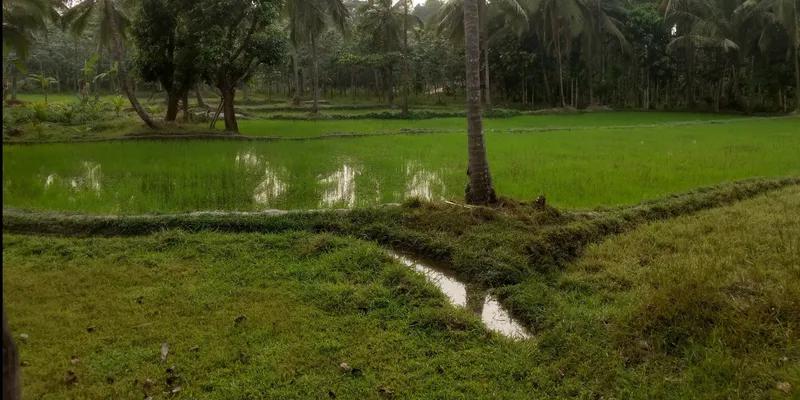
120+ varieties are grown in the monsoon season and 30+ in the post-monsoon season. Plastic tags are placed for identification in the field." alt="
120+ varieties are grown in the monsoon season and 30+ in the post-monsoon season. Plastic tags are placed for identification in the field.
" />Deva Rao’s philosophy “No Fertilizers, No Chemicals”, separates him from rest of the farmers. His produce, being fully organic is in high demand from urban and rural consumers alike. He does not sell his produce to the rice mill, but separates the husk from the rice himself, using a 40-year-old Huller (run on Diesel) and sells his produce directly to the end consumers, who wait eagerly at his doorstep for their choice of rice thereby saving his time and transportation cost. This also fetches him 2 times the price, which a producer would fetch on selling his produce (grown using chemicals and fertilizers) to the rice mill.
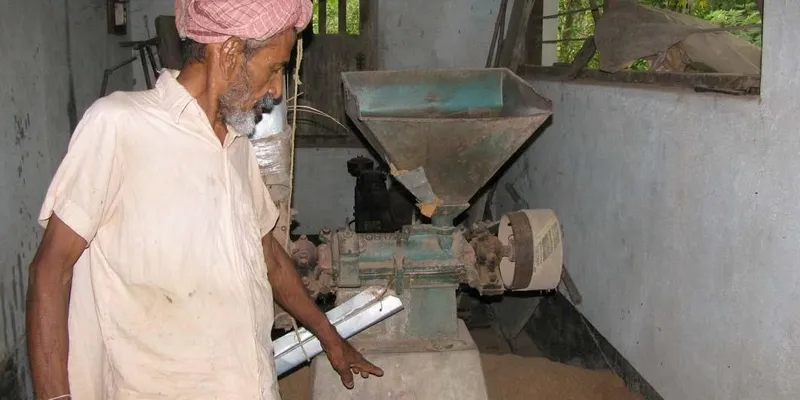
Deva Rao with his 40-year-old Huller (a diesel run machine used to separate the husk from the rice). Parts of the Huller are 70 years old.
For manure, he uses a mix of cow dung, dried leaves, twigs, branches of trees from his farm, which he says is sufficient in quantity. To protect the crops from pests, a mix of Gou-mutra (cow-urine), some herbs and water, sourced from his cow-shed is used.
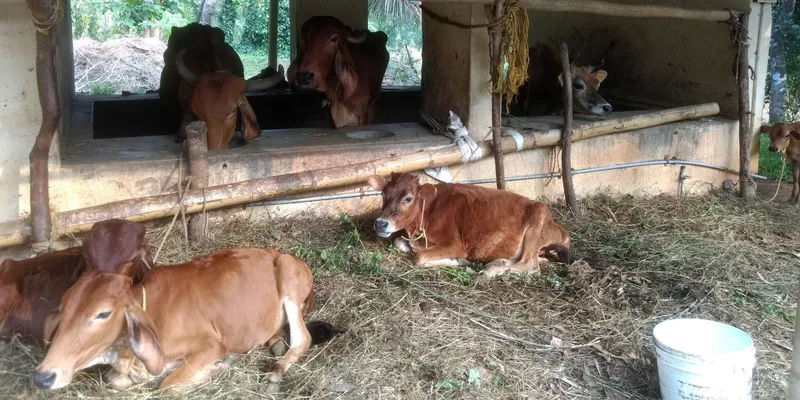
Cow shed at Parameshwar’s house. This breed is the local ‘Gir’ cow. Apart from this, he also rears another breed called ‘Malnad Gidda’.
We visited Parameshwar’s house one Thursday morning (14 December 2017) to know more about their techniques. After about 2 hours of journey from Mangalore, we reached his place at 10 am. We were warmly welcomed in the traditional way - an offering of well water along with pieces of jaggery. Parameshwar explains the scientific rationale – jaggery helps to replenish the sugar level in our body after the long journey.
He then shows us his collection of rice seeds, which they have gathered over the past 20 years. Qualities and properties of a few special varieties of rice are as follows:
Gandhasale – selling at 180/- per kg. It is a small, round variety and is whitish-yellow in colour. It gives out a sandalwood aroma, therefore ideal for making Pulav and Payasam.
Athikaraya - known to contain certain anti-carcinogenic qualities. It is also used as an anti-venom for snake bites and as a medicine for cattle in case of food-poisoning.
Rakthashali - red in colour and increases haemoglobin levels in the blood.
Navara - a very costly variety, selling at Rs. 265/- per kg (in Amazon.com) but he sells them at Rs150/- per kg. There are more than 10 varieties of Navara rice. Colours including black and white, and a harvest cycle ranging from 75 to 150 days. It has high medicinal value, and is used as an anti-venom to treat snake bite patients.
His local variety of Rice includes Kayame, Raja Kayame, Suggi Kayame, Masoori, Kariyajebi, Gulvadisanna. In addition to the above, they have Thailand rice, Manipuri rice (purple in colour), HMT rice, Kavala Kannu rice (frog-eyed rice), Delhi basmati rice, along with their own brand of rice called ‘Swasthi Rice’.

Sample seeds of 155 varieties (including traditional varieties) of paddy kept in containers in Parameshwar’s house.
Parameshwar explains that these traditional varieties of rice slowly started to decline and perish after the advent of the new high-yielding variety of rice (starting with IR-8 and now MO-4), which were introduced to boost productivity and revenues. Alarmed by this, he and his dad, Deva Rao slowly began collecting and conserving these traditional varieties from various like-minded people. They have also collected rice of West Bengal, UP, Bihar and Orissa from Mr. Anil Hegde, a Kundapura based farmer - activist, now residing in Bihar. Certain varieties were given by Mr. Ghani Khan, a Mandya based farmer and Mr. R.G Hegde, a Sirsi based farmer. Certain organisations such as Green Foundation, Karnataka and Navodaya, Delhi have also contributed.

Samples of varieties of rice in small packets in Parameshwar’s house
He explained that unscientific methods are being used to cultivate these high-yielding variety of rice (Mo-4) - excess use of chemicals and fertilizers, lack of crop rotation, etc. - which sucked all the nutrients from the soil without replenishment.
On being asked why he doesn't use chemicals and fertilizers, Parameshwar equates it with poison and recounts an old incident which changed his outlook towards it:
“I still recall during my school days in 1977, when chemicals and fertilizers were used on a large scale in paddy fields, which led to the death of hundreds of jumbo frogs (gonkur kappe), local fish (Morante) and earthworms, creating a horrible stench, which was unbearable. People believed it was good thing, as the rice was now safe from these pests and their decay would become fertilizer. This gave a good yield for 4 to 5 years, after which the natural character of the soil was ruined. The activities of these creatures and many other micro-organisms give the soil its natural character and essence. That is why I never use chemical fertilizers and pesticides.”
On why he chose rice, which is commonly believed to give lower profits than commercial crops such as Coconut, Arecanut, Cocoa, etc., he explains passionately:
“Absorption of rain-water to the ground is very less in case of commercial crops like Coconut, Arecanut, etc. These trees get spoiled if there is excess water logging. Further, the growth of weeds such as Horse grass in these plantations form a thick layer like a carpet between the soil and the roots of these trees, preventing water from reaching the roots of these trees. This makes irrigation through sprinklers ineffective to a certain extent”
“But rice is one such crop, wherein rain-water absorption to the ground is highest. Rice plants absorb water (even from mist) and do not easily let it flow away or evaporate. Water percolation to the ground is highest in paddy. Wherever there is paddy crop, it generally improves the water-level in ponds and wells nearby.”
“Rice is the most effective and practical method of water conservation. It is an important food crop which feeds the people of this region and hence it should not be neglected. Traditionally, our region which used to grow paddy on a large scale, has recently been converted to other commercial crops. Yet I chose paddy, as it helps to conserve water and provides food for the cattle. It has been my passion to study and grow paddy, giving me immense satisfaction” he says.
At this point, he shows us their philosophy statement, a quote from his dad, Deva Rao. This philosophy drives their work day-in and day-out.

Philosophy of Deva Rao, laminated and kept in Parameshwar’s house
Parameshwar mentions to us a unique quality of rice seeds. He says that, rice seeds taken from different places of India adapts to local soil conditions within 2 to 3 harvest seasons.
Deva Rao and Parameshwar use a highly scientific and practical technique of water management. River Netravathi, being the main source of water for people of the D.K region, also flows through Mithabagilu village. Netravathi has its origins in the Western Ghats, and its various tributaries and streams flow across the Aamei area as well. Deva Rao’s farm is situated in the foothills of the Western Ghats. The villagers have traditionally constructed bunds (60+) around such streams in Mithabagilu village, for redirecting the water-flow to their fields.
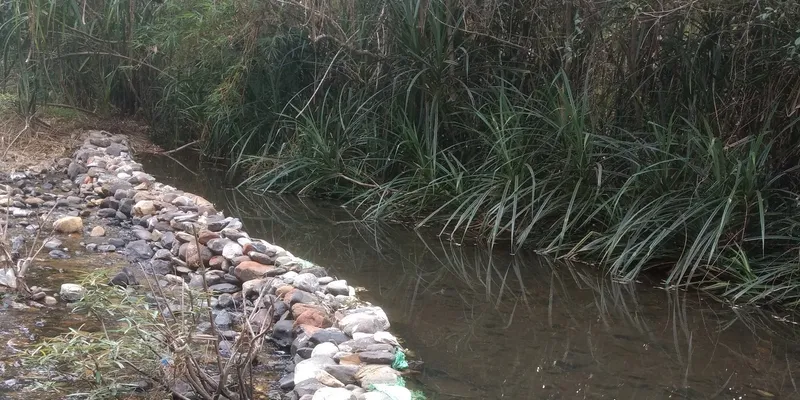
Traditionally constructed Mud Kattas (bunds) to redirect water flow from stream to the rice field through ‘kani’ (canals).
The river has abundant water during the rainy season. But as summer approaches, the water-level in the river starts to decline. Deva Rao and Parameshwar use techniques to collect, store and harvest the excess river and rain water during the rainy season, which would have otherwise flown into the sea. They have constructed several small and big ponds at strategic locations to store excess water. Excess water is redirected into these ponds from the bunds. A network of pipes allows water to be pumped to various parts of the field ensuring water-supply throughout the year.

Water ponds constructed to preserve water. The biggest ‘Gundi’ or pond is 17 ft. in depth and its walls are made out of big granite stones
“The trick is to collect water when it is available and stop its flow into the sea by using artificially constructed ponds and rice fields (which itself act as natural water storage tanks). This helps the ground absorb as much water as possible and thereby increases the water table. This technique of conserving water is known as ‘3S’ i.e. Slow, Stop, Store."
When we asked Parameshwar as to why youth nowadays are not pursuing agriculture and migrating to cities in search of jobs, he opined that wrong government policies are making farmers poorer day by day. If they start getting the right price for their produce, people will take up agriculture more actively. He further laments that even among those taking up agriculture, most of them have shifted from paddy to other commercial crops such as arecanut, cocoa, coconut, and rubber.
“The irony is that a farmer breaks his back and grows rice, without which sustenance is not possible, only to get Rs. 35/- per kg on sale. However, pan masala (supari) made from areca-nut, which is chewn and spat is selling at around Rs. 300/- per kg. This makes me really sad. A better price for rice through appropriate government policy is the need of the hour” he says
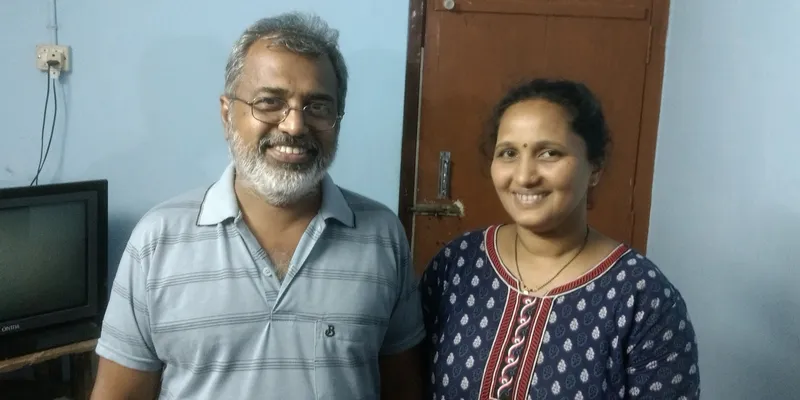
Parameshwar, with his wife Vasanthalaxmi at their residence.
On being asked what motivates him to do agriculture, he says:
“In agriculture, you are your own boss. No other boss to be made happy and you can work and live by your own terms. I don’t have to depend on anyone for daily needs.I don’t buy vegetables from the market as I grow them myself. I don’t have any major expenses when I am at home. And most importantly, at the end of the day, whatever I do makes me happy.”
His wife, Vasanthalaxmi, is very supportive of whatever he does and shares his passion for agriculture. She says that they grow a variety of vegetables such as snake gourd, ridge gourd, sweet pumpkin, cow peas, ladies finger, tapioca, gherkins, yam, brinjal, kokum - which they use in their kitchen and sell the rest. They also have a few jasmine (Mallige) plants, which give them a decent income.
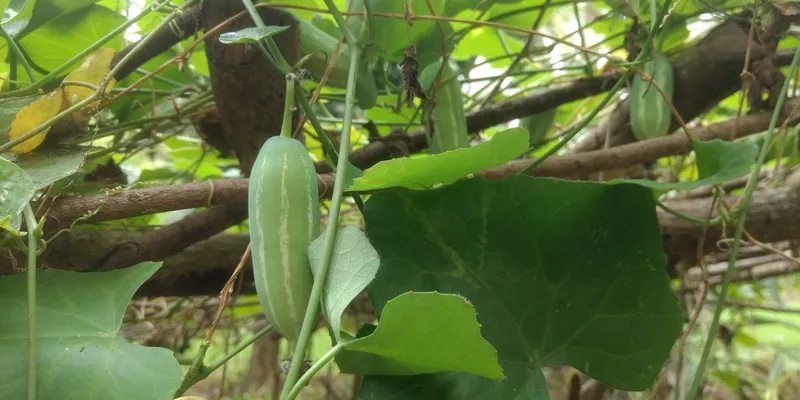
Thondekai (Gherkin) plantation at Deva Rao’s farm
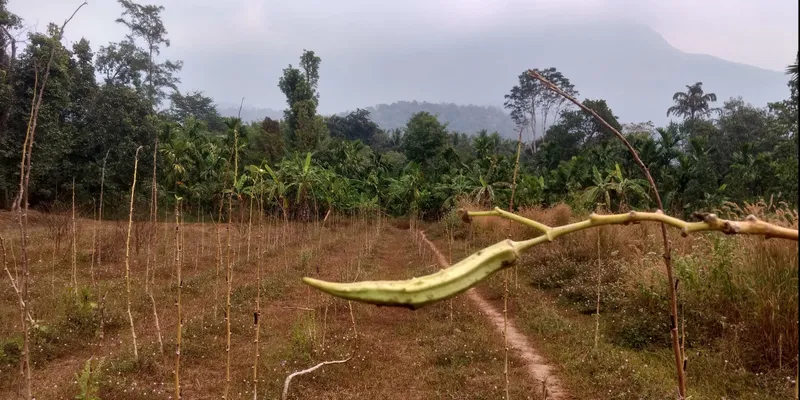
Ladies finger grown at Parameshwar’s field which has just been harvested.
When asked how one can achieve success in agriculture, Parameshwar says, “You need to come up with innovative ideas and implement them effectively”. He tells the story of one family which had 6 daughters and just 25 jasmine plants.
“The family managed to pay-off the marriage expenses of all daughters with the income earned from those plants.” he says.
Parameshwar further supplements the family income through nature tourism and workshops on farming activities. For this, he has tied up with a youth, Mr. Shivakumar, a former IT professional, who worked in multinational companies. Shivakumar shares his passion for agriculture and has also recently purchased land for cultivation in the adjacent village. Shivakumar provides social media related support to Parameshwar in this regard.
They run a Facebook page by the name of ‘Swasthi Farms’. Through this, they organise tours to nearby nature attractions such as Yermai falls, Yeleneeru falls (Samse), Kadama Gundi (Anadka falls) and certain forest treks. Parameshwar provides homestay facilities, including food and snacks at Rs. 750/- per head per day.
Parameshwar has a total 30+ years of experience in agriculture. He holds a diploma in Electrical Engineering and had worked in Bharat Heavy Electricals Limited (BHEL), Bangalore for 2 years after his diploma. During this period, he felt that he needed to return to his roots.
One day, he came across a Kannada translation on the book titled “One Straw Revolution” written by Masanobu Fukuoka, a famous Japanese farmer-cum-philosopher and also a chemical engineer. The main inspiration for Deva Rao and Parameshwar’s work comes from the philosophy of “Do-Nothing farming”, wherein Masanobu worked to develop a system of natural farming, believing that it could be of great benefit to the world. He did not plough his fields, did not use chemicals or fertilizers, did not flood his rice fields as farmers have done in Asia for centuries, and yet his yields equaled or surpassed the most productive farms in Japan.
Parameshwar has worked in an NGO called Nagarika Seva Trust, which ran a seed bank, fought for farmer rights, and against land-grabbing mafia. He believes that development should never be at the cost of environment, but should be sustainable.
Parameshwar gave us a field trip to his farm and explained the practicalities and nuances of what he does in great detail. Later, we came back to his home for lunch and we were served with a delicious meal consisting of 2 varieties of rice (white rice and boiled rice), kokum rasam, papad, cowpeas (alasande) stew, ghrekin curry, green chilli bajji and finally payasam, all made from items grown in their own farm.
After the sumptuous meal, we went over to Deva Rao’s house (which is located approx. 500 meters from Parameshwar’s house). There, we were blown away by the simplicity of the person who was honoured with the SRISTI GYTI Grassroot Samman 2017, conducted under the aegis of President of India, Mr. Pranab Mukherjee for his work on seed conservation during the Festival of Innovation at Rashtrapati Bhavan, New Delhi on March 5, 2017.

Deva Rao (center), with his wife Sharada (left) and daughter Harini (right) with the honours received for his work from various organisation" alt="
Deva Rao (center), with his wife Sharada (left) and daughter Harini (right) with the honours received for his work from various organisation
" />In addition, he has received various state and national level honours and has been recognized by various organisations. In 2000, he was honoured with the ‘Purushottam Samman’ and in 2004 he won the prestigious ‘Sristi Samman’.
His simple lifestyle is evident as he wears no more than 2 pieces of clothes (his uniform, as he calls it). He walks bare-feet and says that he has never worn a chappal or shoe in his entire life due to working in paddy field. He can walk on thorns without any problem.
Deva Rao speaks about the importance of rearing desi varieties of cattle. All his life, he has been rearing ‘Malnad Gidda’, a local cow breed known for giving less milk. But, milk produced from this breed (i.e., A2 milk) is far better than milk produced by foreign breeds (A1 milk) in terms of nutrition and health value.
“The cow-dung produced by foreign breeds stinks, unlike the cow-dung of desi cows does not stink and can be applied on walls and floors and used for producing gobar-gas.” he says.
To sum up his philosophy, he says, “Yield” for me means farm produce that supports not just the family, but also feeds the hungry cattle. I do not equate yield with money. I believe that produce, while feeding human beings with poison-free food, should also feed the animals and other life forms that are dependent on humans with the kind of food they relish and like”.

Deva Rao and family, with Raghunath Mashelkar, Chairman, National Innovation Foundation
For his immense contribution to the field of rice seed conservation, people have given him the title of ‘Thali Tapasvi’ or ‘Krishi Rishi’ which literally means ‘Rice saint’. In conclusion, he says he is content in doing what he does.
“I eat better food than the Prime Minister of India. What else do you need in life” Deva Rao says in a light hearted note, with a smile.




